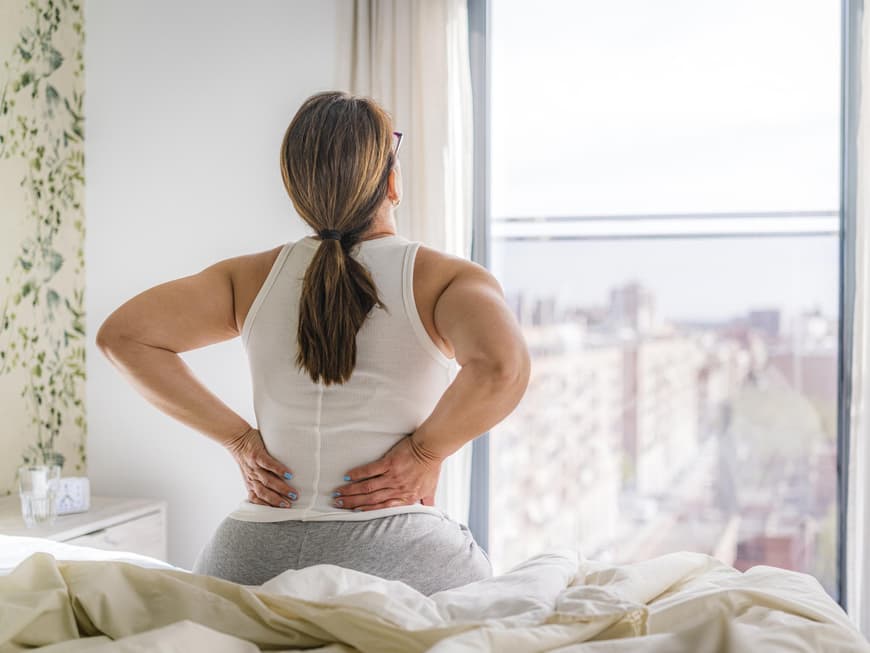
Back pain in the office - what you can do
Sitting for long periods of time is part of everyday life for many people - whether in the office, at home, in the car or on the sofa in the evening. This can quickly add up to six to ten hours of sitting throughout the day.¹ But although it may seem comfortable at first glance, it is a constant strain on the back. Frequent and, above all, prolonged sitting can lead to tension and back pain. However, even small changes in everyday life and a few targeted exercises can do a lot for back health.
What's behind back pain when sitting
Anyone who stays in a seated position for a long time, which is often the case when working in an office, is already causing back pain. This is because sitting does not put enough strain on the muscles in the back, which in the long term leads to a weakening of the stabilizing muscles around the spine.
Sitting in a slouched position, which can easily happen when concentrating on a task, further increases the pressure on the intervertebral discs and restricts blood flow to the muscles and joints, thus promoting tension and blockages.
In addition to a lack of movement and poor posture, psychosocial factors such as time pressure or conflicts can also cause back pain.
Back pain when sitting: You should look out for these symptoms
Depending on whether the back pain is in the lower or upper area, it also varies.
The typical symptoms are
- pulling pain in the lumbar spine, which can radiate into the legs
- Tension in the neck and shoulder area (possibly with headaches)
- stiff neck
- Neck or shoulder pain
In some cases, the symptoms can also radiate to other parts of the body, for example to the chest or legs. Headaches and breathing problems are also sometimes an indication that there is a blockage in the spine or tension.
If you don't work against it, long-term consequences can arise, such as chronic back pain, problems with the intervertebral disc and limited mobility.
However, even a little movement in everyday life, or even better sport for back pain, can provide relief.
What helps against back pain?
The most important remedy for back pain is exercise. The following are examples of back-friendly sports
- Nordic walking,
- jogging,
- Swimming (preferably backstroke or crawl stroke),
- cycling and
- aqua gymnastics.
But during the working day, most people don't have time for a sports session. The good news is that even small breaks from exercise can make a big difference. Especially when you notice that your back pain gets worse while sitting, it's time to take countermeasures. If you regularly change your sitting posture, stand up briefly every 30 minutes or so and walk around or stretch a little, you are already doing a lot for your back health.
However, the ergonomic design of the workplace can also be crucial. This includes:
- ...a chair with an adjustable backrest, combined with the right seat height. The feet should be flat on the floor with the knees at a 90-degree angle.
- ...a height-adjustable desk so that you can sometimes work standing up. This also reduces the strain on the back.
Dynamic sitting is also a good way to avoid back pain in the office. There are chairs that allow you to correct your posture slightly due to the vibration and thus keep you moving while sitting. A sitting ball has a similar function. It also forces the sitter to keep correcting their posture. These small movements improve the blood supply to the muscle chains, which can prevent tension.² However, it takes a while for the body to get used to this new way of sitting against back pain in the office. That's why you should alternate between the classic office chair and the wobbly version from time to time at the beginning.
A little workout for back pain in the office
Of course, it is much easier to get up from time to time and do a few small exercises for your back or walk around the house when working from home, but small exercise routines can also be integrated into everyday working life in the office. For example:
- Shoulder circles
- rocking from one buttock to the other
- Stretching your neck muscles by tilting your head
- Stretching exercises, for example arms upwards
The commute to work is also a particularly good way to loosen up your back. If possible, you should walk or cycle to work, take the stairs instead of the elevator and go for a walk in the fresh air during breaks.
Treating yourself to a massage from time to time or working on tense muscles with a fascia roller can also help to relieve muscle tension. According to one study, just eight minutes of self-massage after four and a half hours of constant sitting can relax and loosen up stiff back muscles.³ All you need to do is place a fascia roller between your upper body and the wall and move slowly up and down. The rolling movement can loosen tense muscles and thus counteract back pain while sitting.
¹ Press office. (n.d.). When your back hurts from sitting so much. Tu-chemnitz.de. Retrieved September 8, 2024.
² Gesundheitskasse, A.-D. (2022, August 23). Sitting correctly in the office: How it works. AOK - The health insurance company. Retrieved September 8, 2024.
Press office. (n.d.). When your back hurts from sitting so much. Tu-chemnitz.de. Retrieved September 8, 2024.
